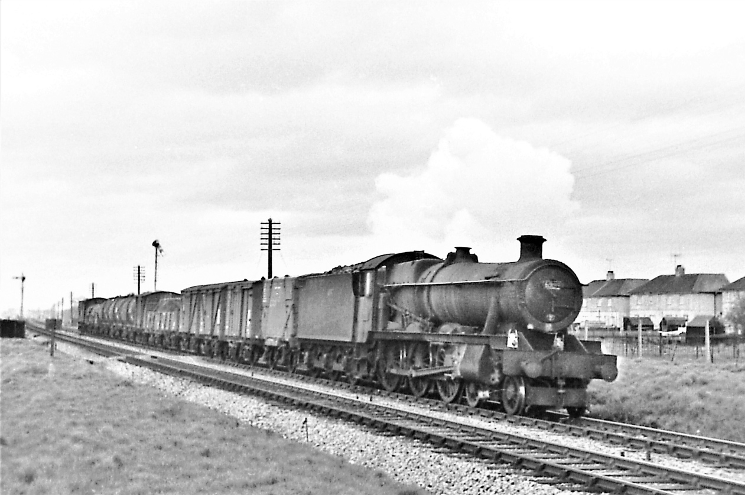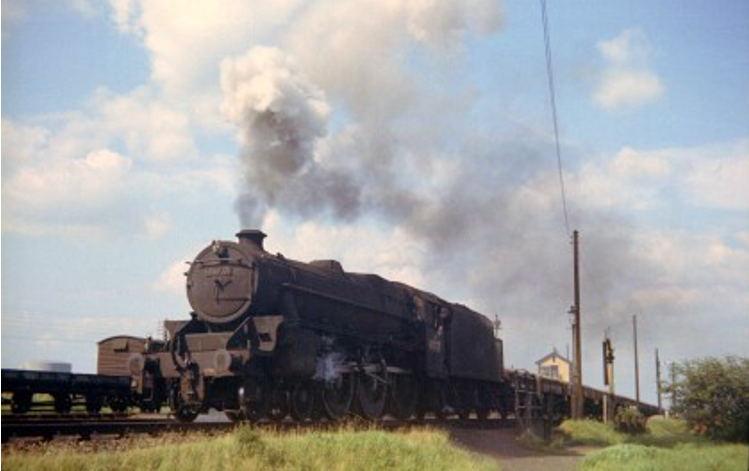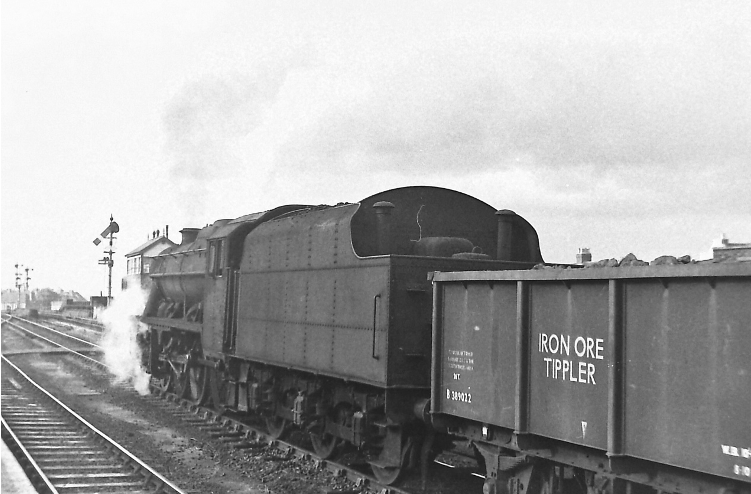1965: Last year of local steam
By spring 1965 ‘Hymeks’ and other diesel-hydraulics had become common, and steam in the Gloucester area was confined to freight trains. I spent time photographing them on occasions I was home, although my records of activity in Gloucester by now were sparse. Even so, at the start of the year I took some atmospheric photos of freight at the ‘Double Bridges’, where the footpath from Stroud Road to Northfield Road crossed the Midland route from Eastgate (Bridge No. 103) and the Western route from South Junction just before the lines met at Tuffley Junction. Then, later in spring I managed to catch two ‘9Fs’ between Grange Road bridge and Naas Lane crossing.
Otherwise, steam was confined to Summer Saturday passenger workings and the odd working on the line to Swindon, including the 12.40pm (Saturdays) Gloucester to Swindon, and the 5.30pm from Swindon to Gloucester. On 17 April, I photographed ‘Manor’ No. 7814 at Hartland Road crossing on the 5.30pm, and later ‘Modified Hall’ No. 6999 at the head of the 6.20pm Gloucester to Acton freight. On 8 May the Saturday 12.40pm was in the charge of ‘Modified Hall’ No. 6993 and was steam-hauled for the last time on July 5 behind Nos. 4100 and 82039.
With steam to spare, ‘8F’ 2-8-0 No. 48367 dawdles past the ‘Double Bridges’ under adverse signals with an up mixed freight, lit by early morning winter sun on New Year’s Day 1965.
0-6-0PT No. 9453 bustles up the grade to the Double Bridges with the morning pick-up freight for Quedgeley on 2 January 1965. By now, with the closure of Barnwood shed, ex-GW and Midland locomotives were used interchangeably in the Gloucester area.
‘Grange’ 4-6-0 No. 6856 (Stowe Grange but minus nameplates) leaves a trail of smoke as it scuttles past Grange Road, Lower Tuffley towards Naas Lane crossing at the head of a mixed freight which includes a pw crane in the consist. The date is 29 March 1965.
‘9F’ 2-10-0 No. 92213 heads towards Gloucester on the Western lines past Naas Lane crossing with a train made up of prefabricated track sections on 29 March 1965.
‘9F’ 2-10-0 No. 92138 speeds north past Naas Lane crossing on the Midland lines with a fully-fitted freight, probably conveying bananas from Avonmouth, on 29 March 1965.
‘Manor’ class 4-6-0 No. 7814 without nameplates (once Fringford Manor) approaches Hartland Road foot crossing with the 5.30pm Swindon to Gloucester local on 17 April 1965.
‘Modified Hall’ 4-6-0 No. 6999 (once Capel Dewi Hall) heads south over Hartland Road foot crossing with the 6.20pm Gloucester New Yard to Acton class 4 freight on 17 April 1965.
During the summer 1965 timetable, Oxley’s ‘Castles’ were supplemented by ‘Granges’ and ‘Britannias’, and so the remaining summer Saturday extras that ran from Wolverhampton via Stratford-on-Avon saw what would become the final change in locomotive provision. On 19 June, I photographed nameless ‘Britannia’ No. 70030 passing Cole Avenue at speed at the head of the 12.30pm Penzance – Wolverhampton. However, on 31 July the same train was back in the hands of a ‘Grange’: No. 6855, filthy, and minus nameplates. By the summer of 1966, the remaining trains using the Honeybourne line were hauled by ‘Brush 4s’. The sole surviving daily service originating at Leamington Spa, now ran non-stop from Stratford-on-Avon to Gloucester (all intermediate stations having been closed despite the service passing through Cheltenham), and towards the end it usually consisted of a GRCW single-car DMU.
Oxley ‘Grange’ class 4-6-0 No. 6855, unkempt (without nameplates but once Saighton Grange), blasts away from a stop for water on the Gloucester avoiding line with the 12.30 pm Penzance to Wolverhampton LL on 31 July 1965.
Officially, dieselisation of the Birmingham – Bristol route was supposed to be complete from 14 June, but this did not happen in practice. Freight was still occasionally worked by WR 4-6-0 classes, often with nameplates removed. In June I obtained photographs of ‘Black 5’ No. 45037 and Standard ‘3’ 2-6-2T No. 82040 in action on freights. Steam visitors from further afield appeared also, the most unusual being ‘K1’ 2-6-0 No. 62057 recorded on shed on 10 June [N. Preedy photo].
I continued to photograph the steam scene in Gloucester whenever I returned home, and on 4 September, a panoramic shot of Horton Road MPD still showed steam in evidence, including ex-LMS locos, as Barnwood shed had been closed in May 1964. I also photographed a westbound iron-ore train from Banbury to South Wales in the hands of ‘8F’ No. 48063 rather than the usual ‘9F’. Later, on 22 October, ‘9F’ No. 92250, the Giesl ejector fitted example, called with the afternoon iron-ore freight for watering and a crew change.
‘Black 5’ No. 4-6-0 45037 (from Stoke 5D) pulls away from Gloucester South Junction after a stop for water on the avoiding line with a southbound train of pipes on 19 June 1965.
‘Britannia’ Pacific No. 70030 (minus nameplates, but once William Wordsworth) has steam to spare as it approaches Tuffley Junction at speed with the 12.30 pm SO Penzance to Wolverhampton LL on 19 June 1965.
Horton Road motive power depot (85B) on 4 September 1965 viewed from the end of the island platform at Gloucester Eastgate, a favourite haunt of spotters. A short engineer’s train headed by ‘4200’ class 2-8-0T No. 5235 ambles towards Central station. With the closure of Barnwood shed, 85B played host to visiting LM Region locomotives.
‘8F’ 2-8-0 No. 48063 attacks the rise out of Central station across the London Road bridge with a train of loaded iron ore tipplers from Banbury to South Wales on 4 September 1965. These trains were for many years worked by Woodford Halse ‘WD’ 2-8-0s. Later, Banbury took responsibility for these turns, which were frequently worked by ‘9F’ 2-10-0s.
On 27 November 1965, a British Railways ‘Farewell to Steam’ railtour from Paddington to Cheltenham called at Gloucester Eastgate hauled by ‘Castle’ No. 7029 Clun Castle, the last of the class, by then allocated to 85B. The four remaining Castles had spent their final days at Gloucester: former stalwarts Nos. 5042 Winchester Castle (once the pride of Horton Road) and 7034 Ince Castle being withdrawn on 30 June 1965.
Interestingly, one of the short-lived class ’14’ diesel hydraulics for local freight work based at Gloucester, D9521, was recorded by the Railway Observer working the 17.00 Gloucester to Cheltenham local service on 27 November, a most unusual occurrence.












